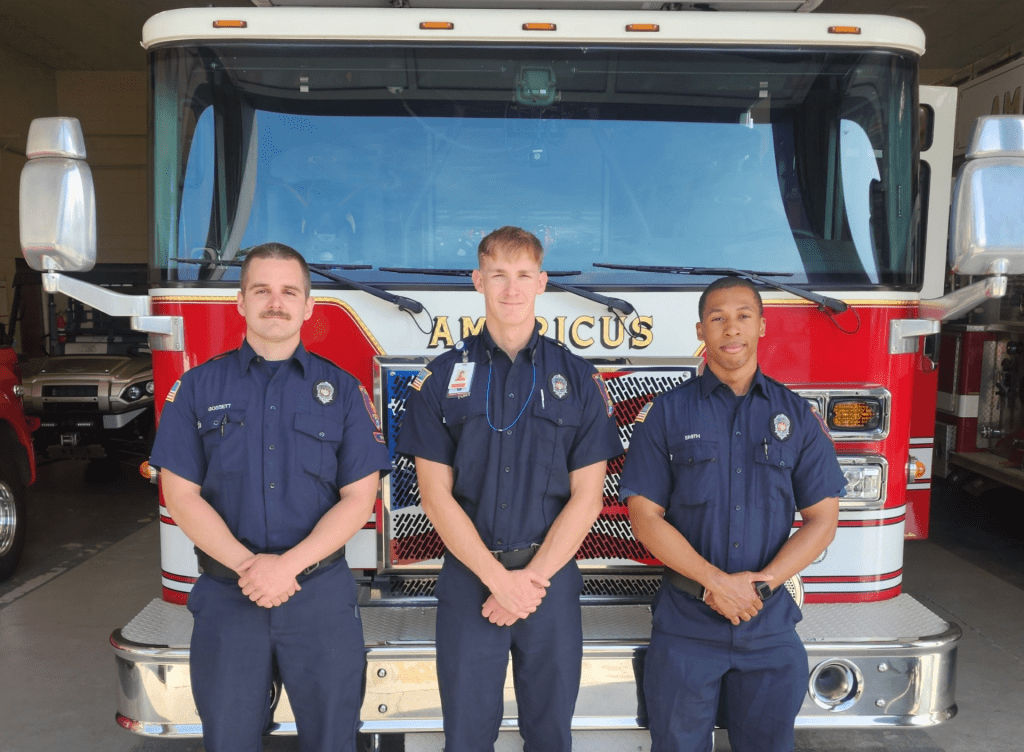Off-duty firefighters respond to heart attack sufferer at local gym
Published 5:46 pm Monday, April 7, 2025

- Off-duty firefighters who responded to heart attack sufferer. From left to right: Adam Gossett, Colman Fort, and Shawn Smith.
Shawn Smith, of the Americus Fire Department, was one of the firefighters who responded after a gym-goer showed signs of heart attack. Smith was at the gym with Colman Fort and Adam Gossett, all off-duty firefighters who were working out at Southwest Georgia Fitness.
Smith’s wife works at the gym. Smith described her reaction. “The way my wife said it was, it was weird to see how instantaneously we all kind of snapped from talking and joking to work mode, which is kind of how it is up here too, because one minute you’re talking, joking. . .and then you might have a serious call, right then.”
Gossett was the first to notice that someone was in distress. He recalls springing into action. “I was exercising and I was watching something on my phone, and all of a sudden I hear a thud. So I look over and I see him laying on the ground.” Gossett quickly called Smith and Fort. Fort also remembers that instant shift. “As soon as it happened, each one of us went into work mode.”
While they were able to respond quickly as a team, Smith notes there were still safety precautions in place that would have been available had they not been there. “In order to be a personal trainer, you legally have to be CPR certified. And the gym also keeps AEDs in the gym.”
However, having a team that train together regularly greatly increased response time. “It was a lot more fluid than a bunch of random people trying to come and work together.”
Smith broke down how long it usually takes for EMS to arrive after a stroke. “It takes the time for people to recognize it, and then from recognition to dialing 911, and then 911 dispatch has to gather all the information and then dispatch us. We have to drop whatever we’re doing and get everybody onto the truck, and from then on, we have to get from the station to the location, so ultimately, that entire timeline could take eight, nine minutes.”
Smith described the training needed to have such a fast response to an emergency, on the clock or off. “There’s multiple routes that you can take to go into the training. I went to the tech school, and I got my certification through the tech school.” Smith was in the second to last class that was given at South Georgia Technical. “Then I came online, and I did two weeks of in-house training from the guys up here. So I come in at 7 am every morning, and I train until 5 pm.” The training for firefighting is grueling. “On the fire side alone, we have to do 240 hours of training a year.”
Training is both mental and physical. “You’re exhausted at the end of every single day, pretty much. And on top of that, after a year of working here, you go through medical training.”
Medical first response is a big part of the Fire Department’s work. “We’re not just firefighters, we’re basic EMTs, advanced EMTs, paramedics. We have to get our CPR certification. There’s a lot of guys here that are CPR instructor certified.” Every other year, they have to recertify their medical training.
Firefighters can work 24-or 48-hour shifts. “Some of the guys have worked 120 hours straight here, and not going home. We can be asleep one second and then three minutes later we’re at a structure-fire fighting fire.” Smith states that their bodies do begin to physically adjust to the rigorous training after about the first half year.”
Not only are state standards strict, but local ones push the Department to a high bar as well. “By Georgia state standard, we have to be able to get dressed in our gear, ready to fight a fire, within two minutes. But the Americus standard, you have to be dressed and ready to fight fire in less than one minute.”






